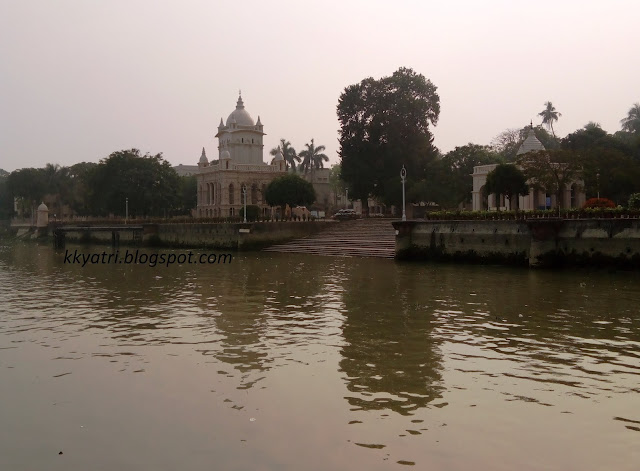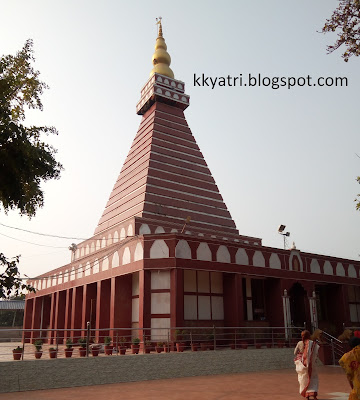 |
The self-appeared Amreshwara Shivalinga
at Angrabadi, Khunti, Jharkhand |
The Amreshwardham Temple is situated in the Khunti district of Jharkhand in the neighborhood of Ranchi district. Earlier it was known as Angrabadi Temple due to the name of the village near which it is situated. The Shivalinga here is situated under a Banyan Tree. It is said that the Shivalinga had appeared here by itself hundreds of year ago. Now a round-temple has been constructed around the Shivalinga but there is not a concrete roof over it. It is said that whenever it was tried to make a permanent roof, Shiva came in the dreams of local people and forbid it. Since the Banyan Tree has grown a big one and it is a habitat of many birds, to protect the devotees from bird-droppings a wire mesh has been placed as a roof and it is partly covered with transparent green fiber sheets around the trunk.
 |
| Maa Durga & Hanuman Temples and Yagyashala at Amreshwar Dham, Khunti, Jharkhand |
I had been here many times before and liked the place much. So when this Sunday our family planned for a devotional outing, I chose Amreshwardham mainly for the peaceful environment here. On Sunday, there is a heavy rush in the temples in the Ranchi town, like Pahari Mandir, Sri Jagannath Temple, and Venkateshwara Temple. And even out of Ranchi, the famous Deuri Mandir and the Chhinnamastika Temple attracts a crowd of devotees like a Mela. The Bhadrakali Temple of Itkhori and Maa Nagar Bhagawati Temples are a bit far away. Hence we decided to visit Amreshwardham.
The place is situated on Ranchi-Khunti-Simdega road at about 50 km from Ranchi. We could leave our house after 09:30 AM. From Kutchery we took the Harmu bypass road to reach Dhurwa and Project Building and this road meets the Ranchi-Khunti road near a place called Hatia. The Ranchi-Khunti road is a National Highway. The road condition is very good. At a roundabout in Khunti, the right turn takes us to Khunti-Simdega road. From here ten kilometers ahead on the right side is the Shiva Temple of Amreshwardham. A welcome Gate is the landmark hear. It was 11:00 AM when we were in the temple. Now there are many temples here and the facilities have improved. We worshiped Baba Amreshwar. The Shivalinga is now covered with a sheet of brass and a railing is made around it. This temple is also very important for local Tribal people.
 |
I remember a visit here when many such devotees called "Bhagatiya" were offering their Puja by rolling their bodies on the ground around the Shivalinga and the Banyan Tree. The Parvati and Ganesha Temples are near the Shiva Temple. When you come out of the Shiva temple there are Radha-Krishna Temple, Hanuman Temple and Maa Durga Temple on the right side while Ram Darbar, Temple Management Building and the Kali temple are on the left. Near the Kali temple, a big Banyan tree and a big Peepal tree are there. Between these trees is a Hand pump in running condition. The potable and cold water machine is placed near the Kali temple. There is a board in front of Temple Management building stating the does and do nots. Also, there is a charge-list for different Sanskaras.
|
 |
The towering Maa Durga Temple at
Amreshwardham, Khunti, Jharkhand |
The Maa Durga temple is unique here. It is towering like a Minar. In 2015 I had written a review of this place on TripAdvisor and uploaded many photos including this Durga temple. The picture was fantastic and later I found some websites had copied and uploaded the same pictures without permission or giving due credit.
There are some Puja-Samagri shops on the main road near the Welcome Gate and one near the Radha-Krishna temple. There is a facility of ladies toilet, but you have to ask for its keys from the management committee which they give readily. After the Puja we sat under the Banyan tree near the hand pump and had Prasada. Spent some time there with the family and came back to Ranchi.
With a vehicle in your hand, the trip will be amazing on the wide and smooth roads that pass through the hills and the Jungles of lovely Khunti District.
===<<<O>>>===












































